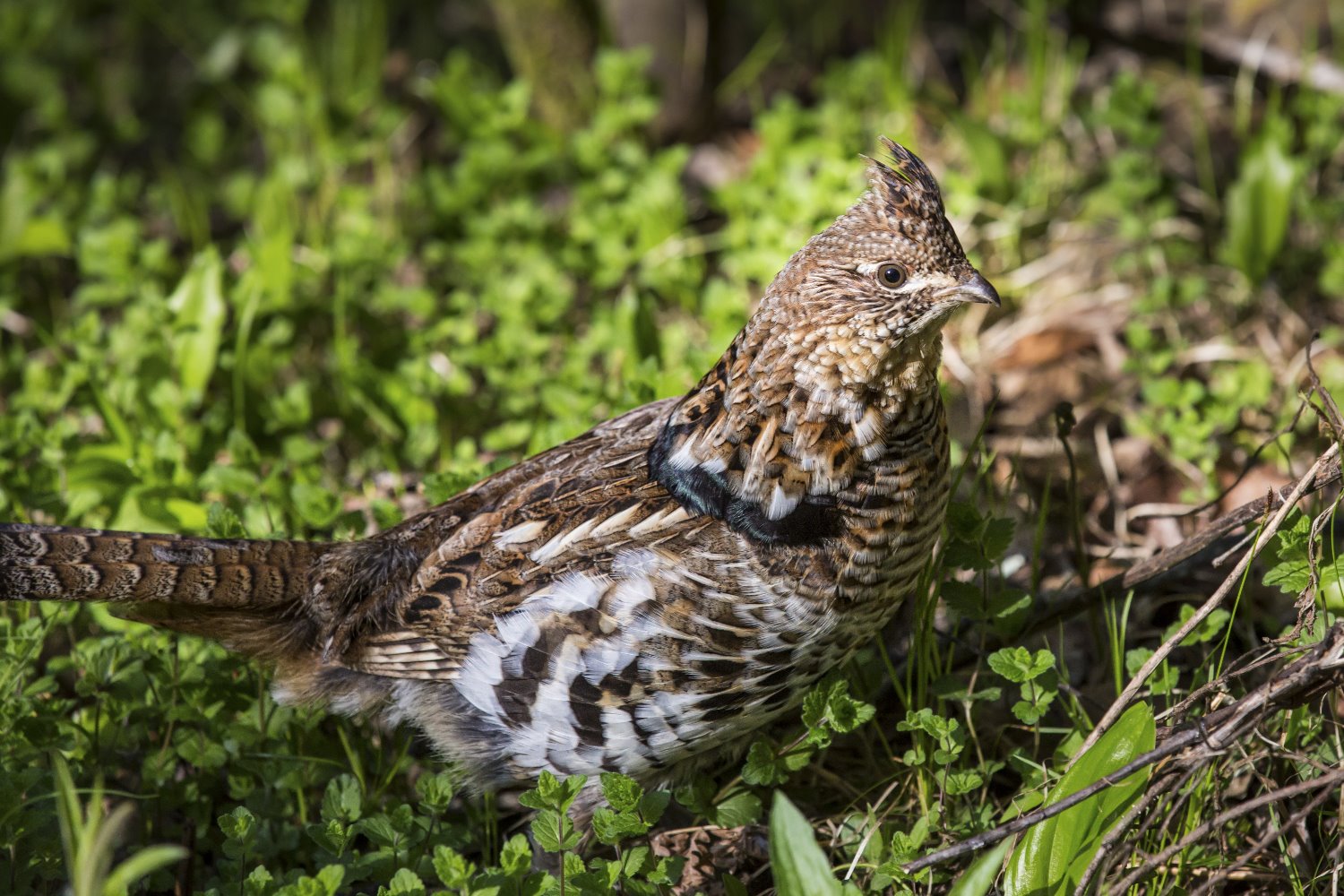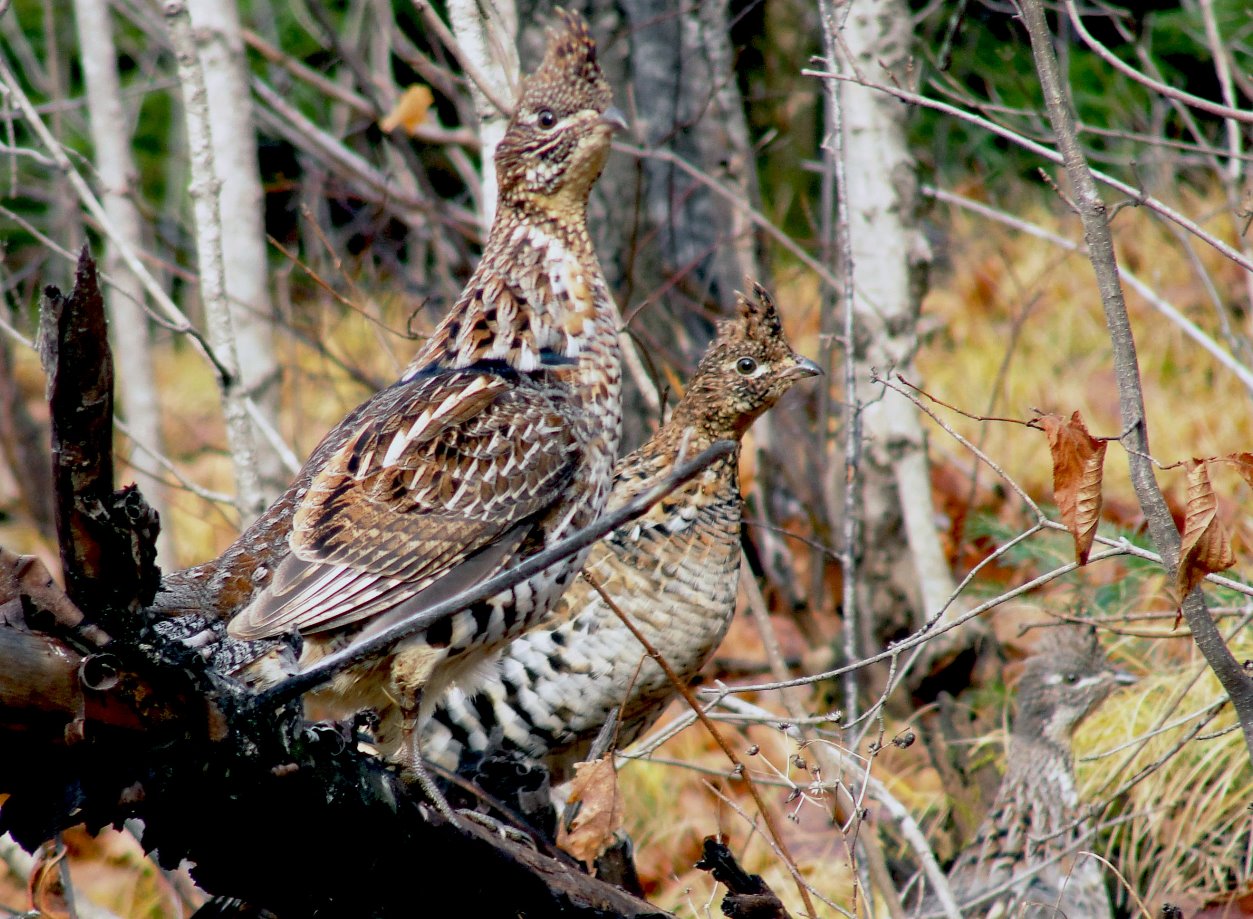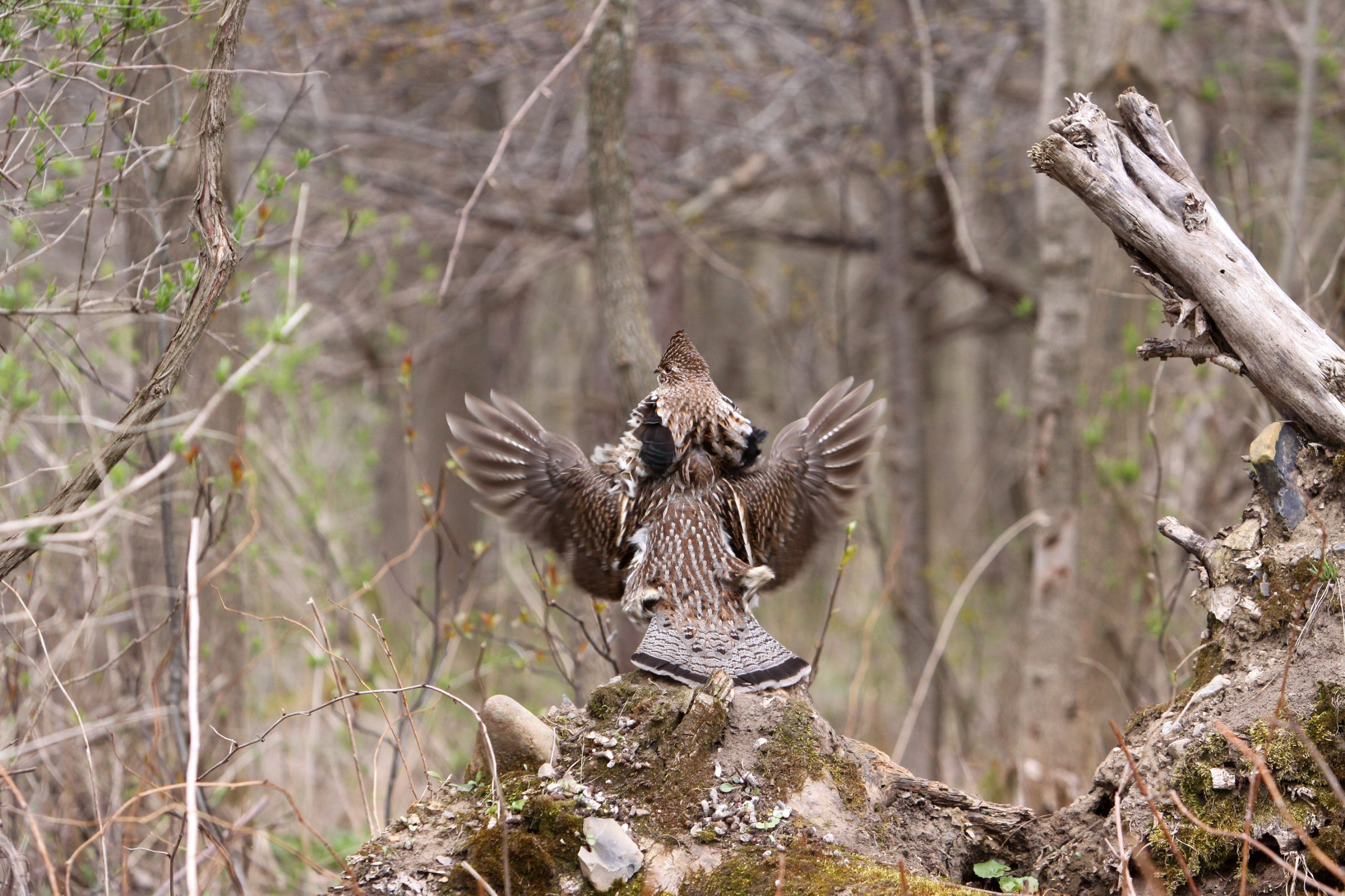
The Woodland Drummer
Stalking the Ruffed Grouse
Ann Jandernoa
April 5, 2022
Why does the Male Ruffed Grouse Drum?
Before winter gives up its grasp on the Northwoods, the male Ruffed Grouse is already gearing up for spring. He will start by visiting his drumming log more frequently in late winter.
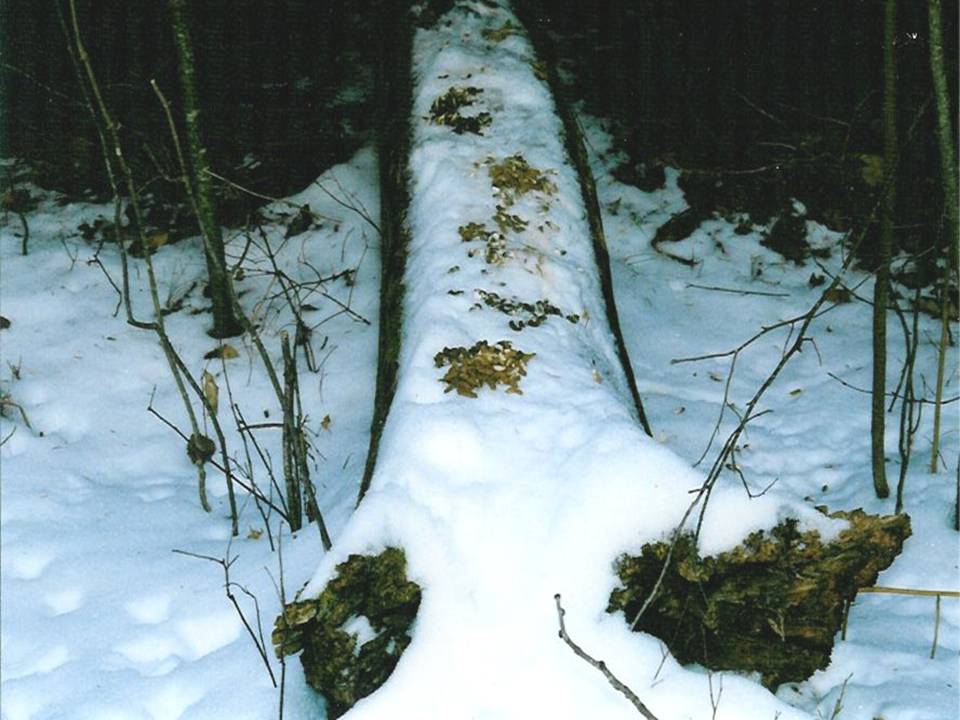
Evidence that a male grouse has been busy visiting his drumming log
Most males are reluctant to drum with snow cover because they become easy targets for predators. A dark object on white snow is easily spotted.
Drumming is used for both defense and for attracting a female Ruffed Grouse.
Defense is the protection of his territory from other males and for advertising his interest in females.
In the spring we associate drumming with the mating season. However, spring drumming is twofold: advertising for females and also announcing to other males that this his territory.
Fall drumming is territorial and is a notification to the young juvenile males that this territory is already taken.
The better the habitat, the more males that can be found within a given area.
My focus has always been to locate the areas where there are multiple male grouse drumming. Once I have located these areas, I will spend time stalking each drummer.
I learned a lot about habitat requirements through observation—the difference
between a juvenile drummer and an adult. After a while, it was easy to spot patterns of habitat needs, escape routes, and how each male had specific requirements to be able to call a specific location their own.
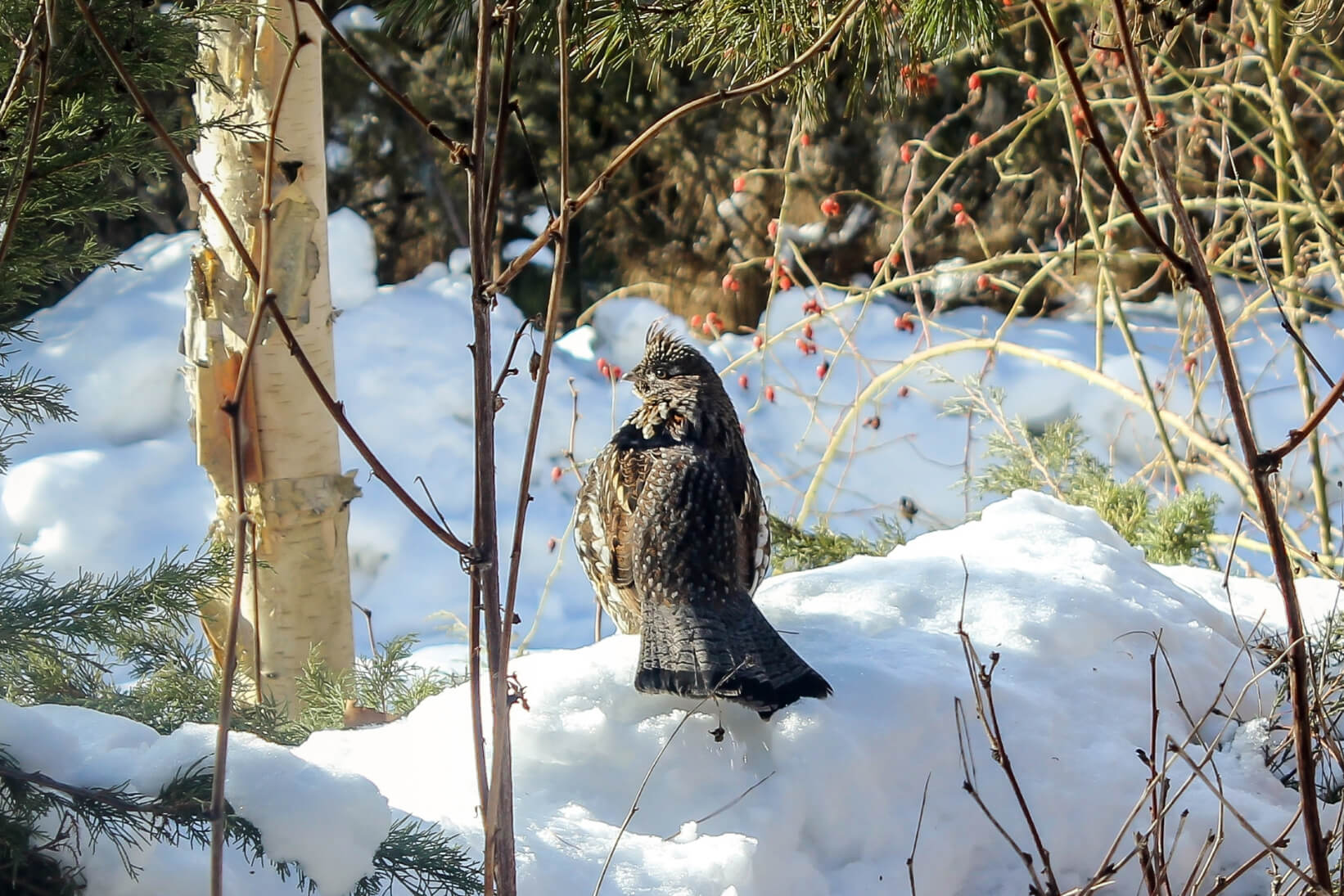
Waiting for spring
How the Drumming sound is created
Drumming sequence last from 5 to 8 seconds. The video to the right has been slowed to 45 seconds and still the wingbeats are a blur.
- The male grouse creates the noise by leaning back on its tail and striking his wings against the air, forming a momentary vacuum.
- This noise will last from 5-8 seconds and can be heard up to ½ mile away along lakes and ¼ mile in the woods. In dense pine and spruce cover, the sound may only carry for 1/8th of a mile.
- The male grouse will typically beat his wings 45-48 times within 5 to 8 seconds of drumming.
- Some male grouse may switch directions when drumming, thus throwing the sound off by 30-40 degrees. This can cause confusion in trying to locate a bird.

The stage is set, and the male Ruffed Grouse becomes the woodlands director.
Drumming Log Specifications
Located on the drumming log, chosen by the male grouse, is an 8” area referred to as the drumming stage where he stands to drum.
When looking at drumming sites, one can easily tell the primary direction that the grouse faces while drumming by locating the pile of droppings.
Typically, but not always, the male Ruffed Grouse will drum facing East.
The drumming log also needs to be a minimum of 12-14 inches elevated. Dense shrub composition also needs to be located around the drumming site.
The male grouse likes to have 40-60 degrees viewing area while drumming. All this is needed for a male to feel comfortable while on his drumming log.
The log that is used the most is called the “primary log”. Sometimes a grouse will use another log and that is called an “alternate log.”
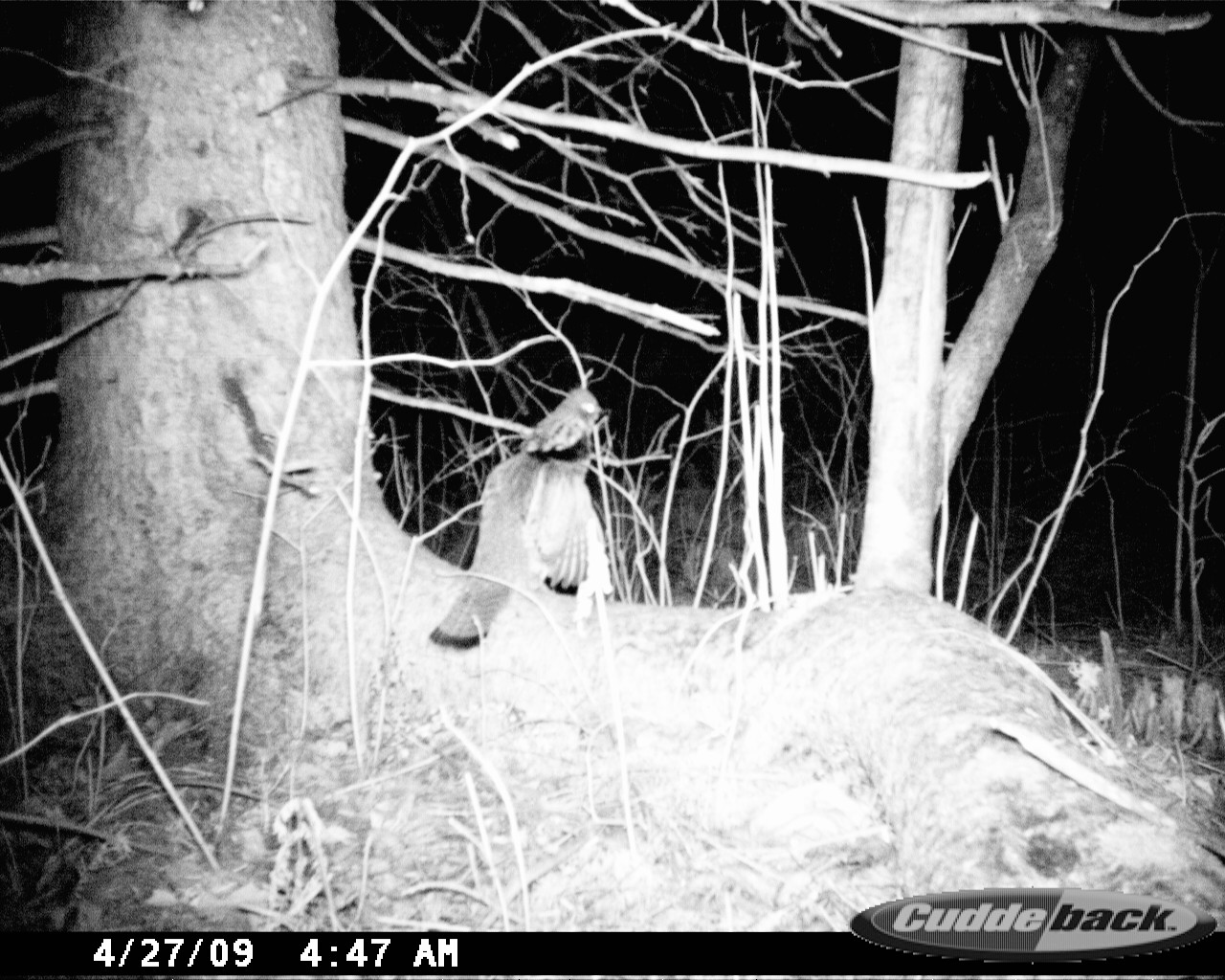
Even when it is dark the male grouse may drum or even hang out on or near his drumming log.
Take time to look for fresh droppings and for molted primaries. These are indications of whether a log or drumming site is being visited regularly.
The male ruffed grouse has also been known to drum on rocks, piles of dirt, wood piles.

This male grouse chose a pile of dirt. This picture was taken in the fall. This young male chose a site that isn’t very secure.
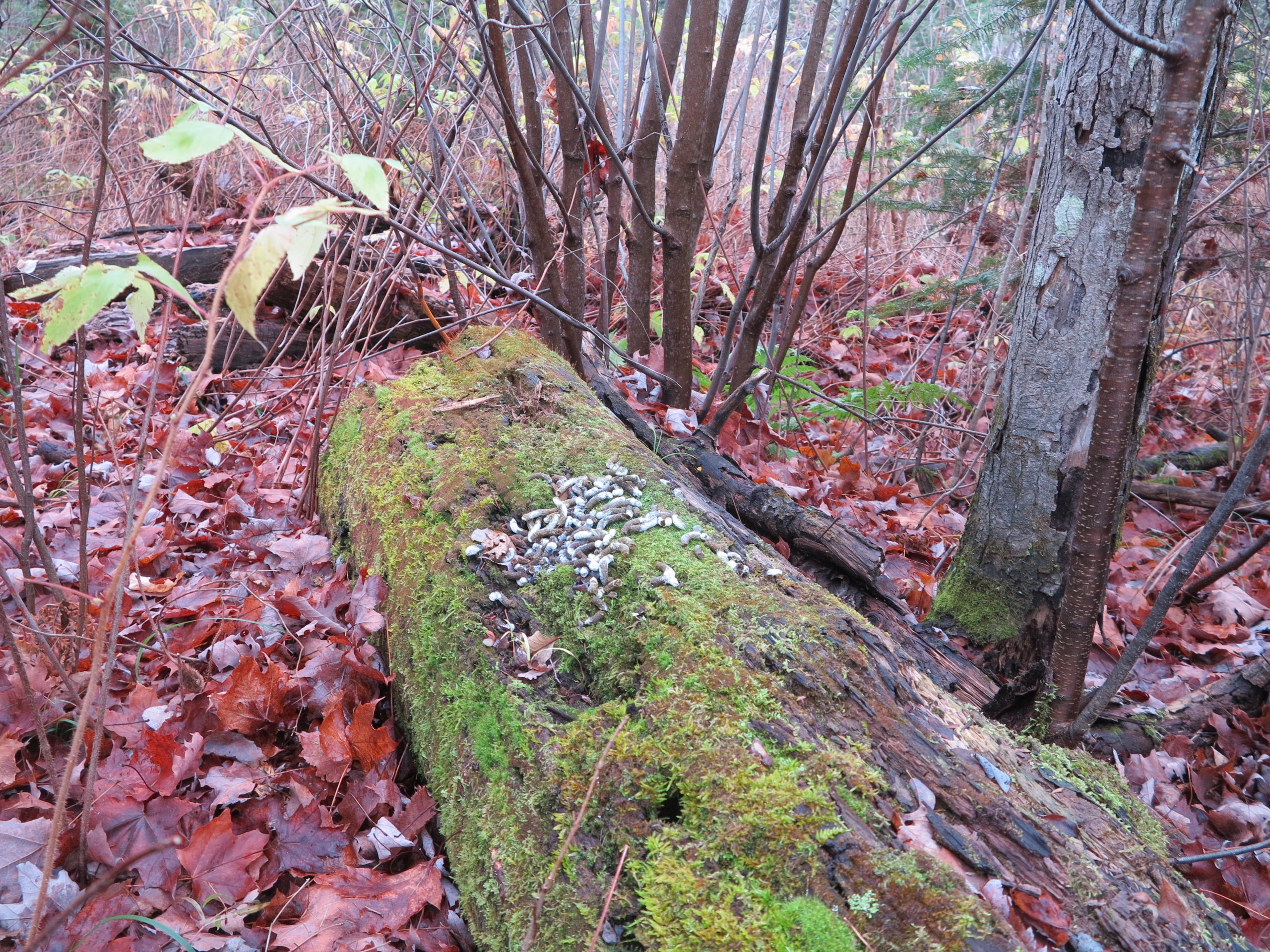
Weather and Drumming
Research from Gordon Gullion showed the following relationship to weather and drumming. Gullion’s research was conducted in the Cloquet State Forest, Minnesota.
Temperature
“During late April, the highest level of activity is usually when sunrise temperatures are between 24F and 36F and rising rapidly. Typically, if early morning temperatures are above 42F fewer grouse will be drumming.” Gordon Gullion
Moon Phases
“When a full moon coincides with the peak of drumming, night use of logs is more common.” Gordon Gullion
Rain
“During peak drumming season even, a light drizzle didn’t stop the males from drumming. However, rain showers would stop drumming all together.” Gordon Gullion
Wind
“Windy conditions are tolerated by male ruffed grouse during drumming season.” Gordon Gullion
Fog
“Foggy mornings work just as well for drumming males. Fog seems to amplify the loudness of the sound.” Gordon Gullion
Drumming Intervals
During the peak of the drumming season intervals are typically 4 minutes apart
If the male is by himself, the drums can be 8, 12, 16 minutes apart
When a hen is nearby, the drums can be 1 minute apart
For many years I have stalked the males when they drum. Most of the time this was done to locate their position in order to put up trail cameras.
Before stalking, position yourself west of the drummer. Most grouse typically drum to the east. However, once in a while the bird will switch directions.
- Try to get as close as you can without alarming the bird.
- Determine the interval between drums.
- Sound of the next drum start moving as fast as you can in the direction of the noise.Be ready to stop before the drumming stops. By knowing the drumming interval, you will know about to stop moving.Repeat the process multiple times. As you get closer to the sound try not to move as much during the drumming process.
- If you see the grouse, watch for the direction he slips off the log. This will indicate one of his escape routes.
- Once you have located the log. Check on which side he was drumming. This way you will know where to place your game camera. Pile of droppings will be on one side of the log. The bird will face opposite of the droppings.
- As you leave the area of the drumming site, look at the habitat around you. Look for small openings or even trail junctions. These can be good areas to set up cameras.
- Stalking drumming males works best if the drums are 4 minutes or less apart. The males are preoccupied and more distracted.
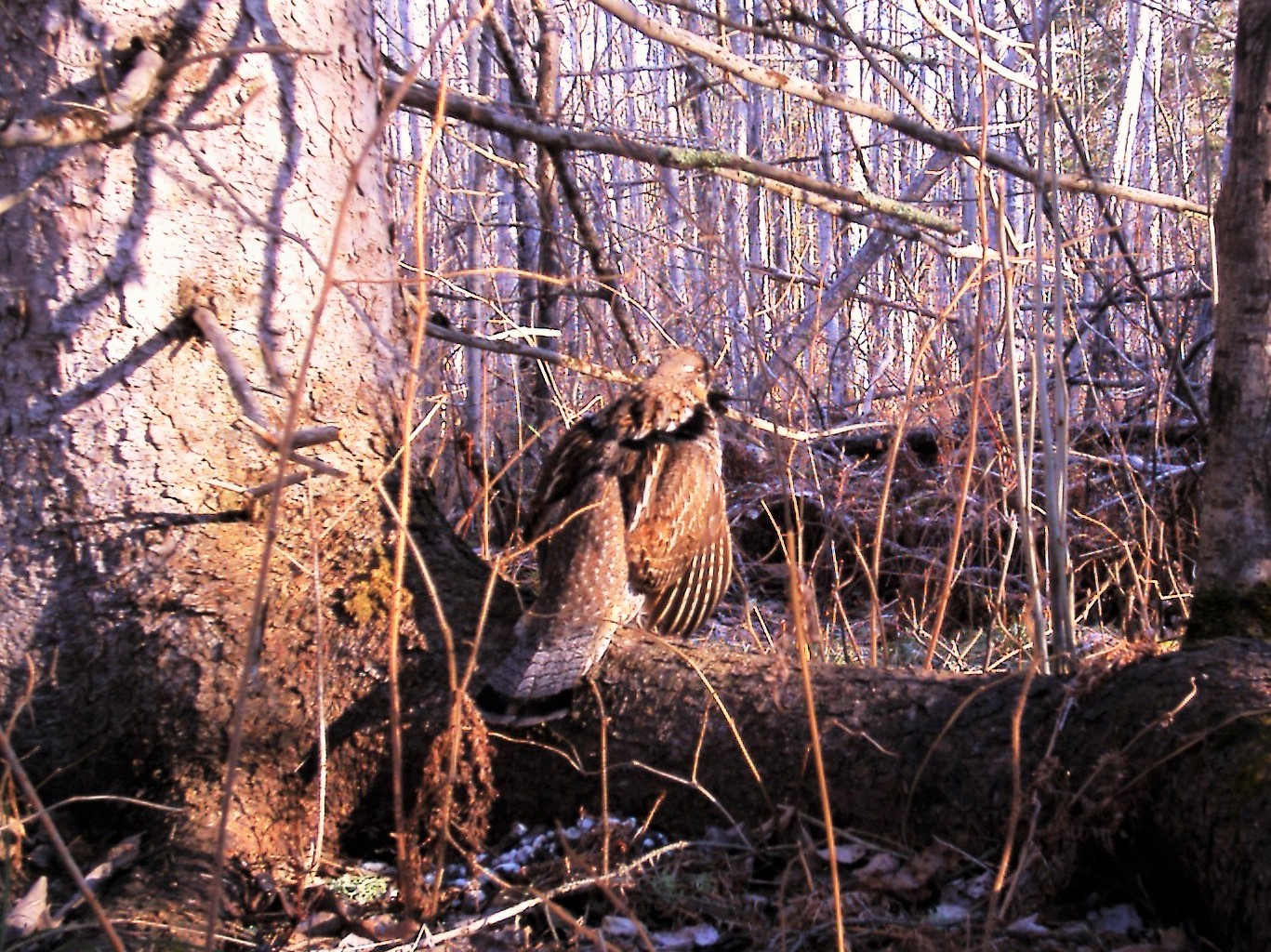
This male drummer is using the root of a White Spruce tree as a drumming log. Note, he is catching the first sun rays of the morning facing to the east
Mating season is short lived
The peak of the drumming season is short. Typically lasting less than a week for any one male.
In the northern part of the Lake States, drumming season typically starts April 20th through the last few days of April.
During the first part of May, there is a break of about 10 days. Thought is the break coincides with migration of Hawks traveling north.
Drumming will start back up around May 15th and continue into June.
The Ruffed Grouse Display
The display that the male grouse puts on is a sight to behold. Stomping the ground, shaking his head, tail fanned out and strutting.
(Video to the right. There are two males and a female in front of the two males.)
Even though he looks impressive, it doesn’t mean the female is impressed.
There have been many times I have witnessed the males courting a female. Once I sat in the woods over 30 minutes watching all the antics the male went through trying to get the female’s attention.
The male grouse would display and strut trying to impress the hen, and when he did not get a response, he would switch over to pecking at the ground.
Next the male would act like he wasn’t interested in her but all the while cautiously getting closer. Then the display and strutting would start again.
Typically, the strutting followed by the direct charge, results in the female flying off leaving the male trying to figure out what just happened.
Fall Drumming
Around late October we will hear the drum of a juvenile that has staked out his little corner of the world. Sometimes I find the new drumming site and look at it and wonder what the bird was thinking.
One time I was hunting an area that had two adult drummers in very close proximity to each other. My dog, Northern Bean, went on point and up ahead I could see the drumming log.
I quickly scanned past the log and saw the bird slipping away. We proceeded forward and the bird flushed, but not before another bird flushed to our left. We then worked our way over to the log of the neighboring grouse. We flushed that bird and then a second bird. Lesson learned: early fall drumming can mean multiple birds within a given area. The adults will try to slip away but the juvenile male will often linger a little too long. We took one male (juvenile) out of that area.
The seasoned adults will slip away from their drumming areas while the juvenile males tend to hang around.
Typically, the adult males are the first to drum in mid-September and early October, due to the pressure from the juvenile males.If the site is too open with not enough cover; he will never make it till spring. Then I find some sites that are just perfect; they have plenty of cover, good visibility, are almost predator proof and hard for a hunter to access.
After the Drumming Season
The hens will start to regroup in the male’s habitat late fall and will utilize + or – 25 acres in and amongst multiple male’s habitats.
The hen spends her winter in and amongst the males sharing their habitat. Many times, the hens are in a group and circulate from one male’s territory into another male’s territory.
The male’s habitat it suited to support him year road with food, cover and escape areas no matter the season.
In spring the hen can shift up to 1/2 a mile or less being drawn from where she spent the winter once drumming has started.
After mating with the male, the hen will leave the area and look for a suitable site to make a nest.
Thus begins the next chapter in the life of the Ruffed Grouse.
I believe you can spend a lot of time reading about a grouse and not understand a
grouse. To know the grouse, you need to learn their needs.
These needs can range from specific seasonal cover requirements, escape routes, seasonal food requirements, and daily schedules. The daily schedule will vary with temperature, wind, dew, and barometric pressure. The life of a Grouse is complex.
Taking the time to learn the habitat and the birds needs and then correlating those areas on maps is the difference between occasional success and consistency in locating grouse.
The Biologists that have inspired my search for knowledge
A special thanks goes to all the biologist that have studied the life of the Ruffed Grouse. If it wasn’t these individuals, we would know very little about this unique bird.
Recommended Reads for more in-depth Ruffed Grouse knowledge
The Ruffed Grouse by Gordon Gullion
Gordon Gullion, who died in 1991, devoted his life to researching ruffed grouse, and he changed the way we think about northern forests.
Gullion was a pioneer in grouse research at the Cloquet Forestry Center in the late 1950s. Guillion also was known for his research concerning the relationship between forestry practices, aspen and the life cycle of the Ruffed Grouse at the Cranberry Unit of Mille Lacs Wildlife Management Area. Gullion’s life passion represents 30 years of research about the Ruffed Grouse.
The Ruffed Grouse: Its Life Story, Ecology And Management
By Gardiner Bump (Author), Robert W. Darrow (Author), Frank C. Edminster (Author), Walter F. Crissey (Author), Fred Everett (Illustrator), Clayton B. Seagears (Illustrator)
The above authors were also Pioneers in the research of the Ruffed Grouse. This is
another excellent book,
